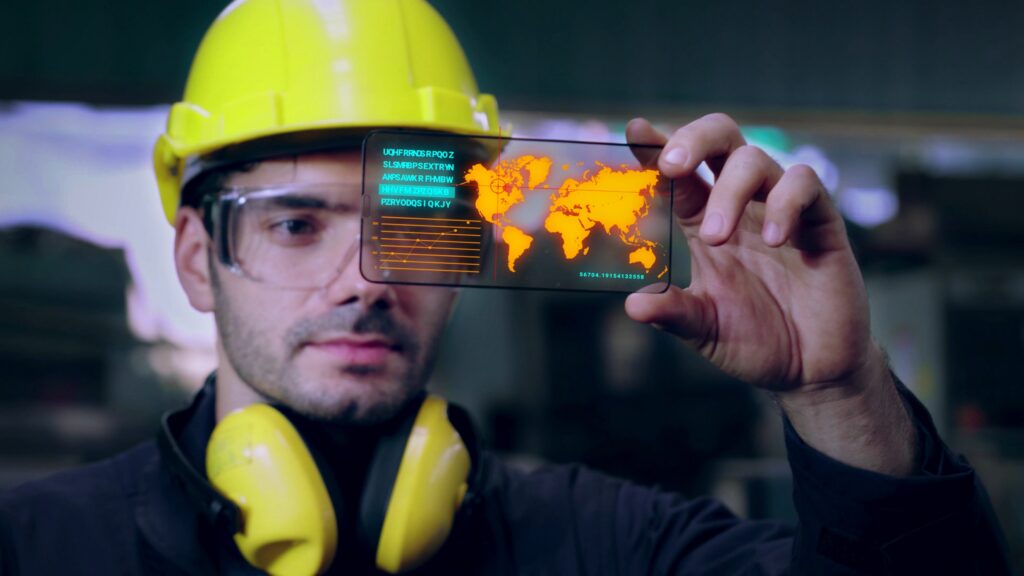Augmented Reality (AR) has emerged as a pivotal technology in the rapidly evolving Industrial 4.0 landscape, reshaping operations across various sectors. AR brings cutting-edge solutions from manufacturing to healthcare, enhancing efficiency, safety, and problem-solving capabilities. Selecting a trusted AR supplier is crucial, as it ensures access to the latest technology, reliable support, and a product tailored to specific industry needs.
Navigating the AR Supplier Market
With many AR suppliers, industries face the challenge of identifying a genuinely effective and trusted partner. Key to this process is understanding your Industry’s unique demands and conducting a thorough vetting process to evaluate suppliers’ reputation, technical expertise, and ability to offer customized solutions.

presentation to try
Nsflow in action
Understanding AR in Your Industry
Augmented Reality (AR) has significantly transformed the industrial sector, offering innovative solutions that reshape traditional practices. Its diverse applications range from enhancing training methods to improving maintenance efficiency, revolutionizing design processes, and beyond.
- Training and Education: AR introduces interactive, virtual experiences that transform traditional training methods. It allows for safer, more immersive training scenarios, particularly beneficial in environments where hands-on experience is crucial but traditional methods are risky or costly. AR can reduce instructor involvement and ensure better standardization of knowledge transfer.
- Operators’ Daily Work: Augmented reality (AR) technology is revolutionizing the daily routine of operators across industries. It offers real-time information and guidance, enabling operators to complete tasks more efficiently and accurately. AR overlays provide instant access to diagrams and operational guidelines, document assembly processes, reduce the need for manual inspections, and improve on-the-fly decision-making. This leads to improved workflow, reduced downtime, and the ability to resolve issues, ensuring continuous and optimized operations quickly.
- Maintenance and Repair: In maintenance, AR’s digital overlays provide technicians with real-time, step-by-step guidance. This enhances task precision, reduces the likelihood of errors, and streamlines the maintenance process, making it more efficient, effective, measurable and trackable.
- Design and Prototyping: AR significantly aids the design and prototyping phase by enabling the virtual visualization of prototypes as Digital Twins. This allows for rapid iterations and adjustments, improving the design process’s speed and accuracy.
- Remote Assistance: AR is a game-changer for providing expert guidance remotely. It facilitates faster problem resolution by allowing experts to overlay instructions or information directly into the user’s field of view, irrespective of their physical location.
- Warehouse Management: In inventory management, AR streamlines operations by guiding workers to specific items and providing essential information through visual cues. This innovation enhances efficiency, reduces errors in large-scale warehouse operations, and provides detailed analytical data.
Each of these applications highlights the versatility and impact of AR in the industrial sector, underscoring its role as a transformative technology that’s reshaping how industries operate, train, and solve complex challenges.
Identifying Your Industry-Specific AR Needs
Selecting the appropriate Augmented Reality (AR) application for your Industry involves deeply understanding your sector’s specific challenges and objectives. This understanding is crucial for ensuring that the AR technology integrates seamlessly into your operations, addresses critical issues, and enhances overall efficiency.
Analyzing Industry-Specific Challenges
Evaluate your Industry’s unique operational inefficiencies and challenges. This analysis should include identifying areas where current processes could be optimized or where AR technology could solve existing problems. Understanding these challenges helps pinpoint the exact features and capabilities your AR solution should possess.
Defining Objectives for AR Implementation
Setting clear, achievable objectives for incorporating AR into your business processes is essential. These objectives should be closely aligned with your overarching business goals. Whether it’s enhancing training effectiveness, improving maintenance accuracy, or streamlining design processes, your objectives should dictate the direction of your AR strategy and help in measuring its success post-implementation.
Considering Customization and Scalability
Given the rapid pace of technological advancement, choosing AR solutions tailored to your current industry-specific needs is essential and capable of scaling and evolving. Customization ensures that the AR application fits seamlessly into your existing workflows. At the same time, scalability and the potential for future enhancements mean that the solution will continue to be relevant and beneficial as your business and Industry evolve.
Calculating Potential ROI from AR Implementation
In addition to the critical steps of identifying industry-specific AR needs, analyzing challenges, defining objectives, and considering customization and scalability, it’s vital to incorporate a calculation of the potential Return on Investment (ROI) when implementing Augmented Reality (AR) technology.
- Quantifying Benefits: Estimate the tangible improvements AR will bring. This includes increased efficiency, reduced error rates, enhanced customer experience, and other measurable gains relevant to your industry objectives.
- Cost Assessment: Consider the total investment required for AR implementation. This encompasses the initial cost of the AR technology and any ongoing expenses for maintenance, updates, and training.
- Expert Partnership for Accurate Estimation: Collaborating with an experienced AR partner can significantly aid this process. They can provide insights into the costs and benefits specific to your industry, helping to forecast the economic impact more accurately.
- Time Frame Analysis: Evaluate the ROI over different time frames. AR technology might have a substantial upfront cost, but its efficiency and productivity benefits often increase, leading to a higher ROI in the long run.
By carefully considering these factors, you can identify AR applications well-suited to your Industry’s unique context, thereby maximizing the technology’s impact and ensuring a solid return on investment.
Learn More about Nsflow Features
Criteria for Choosing a Trusted AR Supplier
Selecting a trusted Augmented Reality (AR) supplier is pivotal in ensuring the technology aligns with your business needs and delivers its intended benefits. When making this crucial decision, several key factors must be taken into account:
- Expertise and Experience: The supplier’s track record and technical capabilities are fundamental. Look for a provider with a proven history in the AR field, demonstrating their ability to deliver effective solutions and navigate the complexities of AR technology.
- Quality and Range of Products/Services: Assess the innovation and diversity within the supplier’s product portfolio. A wide range of high-quality, cutting-edge solutions suggests a deep understanding of AR technology and its applications across different industries.
- Customer Support and Service Reliability: Post-purchase support is as important as the product. Adequate after-sales support, including customer service and training, ensures you can maximize the AR technology’s use and promptly address any issues.
- Compatibility and Integration: The AR solutions should seamlessly integrate with your existing systems and workflows. This compatibility minimizes disruptions and facilitates a smoother adoption of the technology in your operational environment. Check the openness and ability to customize solutions instead of offering only box solutions. Make sure that, in addition to the service, you will receive access to consultants/experts at every stage of the AR implementation project in your company.
- Security and Data Privacy: In an era where data is invaluable, ensuring the AR supplier adheres to stringent data privacy laws and has robust security measures is essential. This protects your sensitive data and maintains the integrity of your operations.
Check: Nsflow Industrial Platform in a Plug & Play Version
By carefully considering these criteria, you can choose a trusted AR supplier that offers technologically advanced solutions and aligns with your specific business needs and operational dynamics, ensuring a successful and secure integration of AR technology into your business processes.
Testing and Piloting AR Applications
Conducting a thorough testing and piloting phase is crucial before fully committing to an Augmented Reality (AR) solution. This step ensures the AR application aligns with your specific operational needs and objectives.
- Define Objectives and Success Criteria: Establish clear, measurable goals for the pilot project. These objectives should reflect what you aim to achieve with the AR technology, and they will serve as the benchmark for evaluating the pilot’s success.
- Select a Pilot Area: Select pilot users and provide them with proper initial training. Identify a representative segment of your operations that can effectively demonstrate the AR application’s impact. This area should sufficiently indicate your broader operational context but be manageable in scale to facilitate focused testing.
- Implement and Monitor the Pilot: Deploy the AR solution in the chosen pilot area and commence a detailed documentation process. Regular monitoring of the pilot’s progress is crucial to understand how the AR application functions in a real-world setting and to identify any issues or areas for improvement.
- Gather and Analyze Data: Collect quantitative and qualitative data throughout the pilot phase. This might include performance metrics, user feedback, and observational notes. A thorough analysis of this data will provide valuable insights into the effectiveness of the AR application and whether it meets the predefined objectives and success criteria.
This structured approach to testing and piloting AR applications is a critical step in the decision-making process, ensuring that the technology is technically sound and adds value to your operations.
Check out a Free 14-day trial with Nsflow

Conclusion: Embracing AR for Future-Ready Operations
Augmented Reality (AR) technology is spearheading a revolution in Industrial 4.0 operations, necessitating a thoughtful and strategic approach to its adoption and integration. In this article, we delineated the essential steps in this transformative journey, emphasizing the importance of an organized and informed process:
- Recognizing AR’s Potential: The first step is understanding the vast potential of AR technology, identifying its diverse applications, and acknowledging the benefits it can bring to your specific Industry. This foundational knowledge is crucial for leveraging AR effectively.
- Tailoring to Industry Needs: It’s imperative to align AR solutions with your Industry’s unique challenges and requirements. Customizing the technology to meet specific operational needs ensures that it adds tangible value to your business processes.
- Vetting Suppliers Thoroughly: The selection of a supplier should be based on their expertise, the quality of their products and services, and the reliability of their support. A thorough vetting process is essential to finding a supplier to meet your expectations.
- Research and Shortlisting: Conducting comprehensive research is necessary to identify suppliers capable of meeting your Industry’s specific AR requirements. This step helps in creating a shortlist of potential suppliers for further evaluation.
- Systematic Supplier Evaluation: The shortlisted suppliers should be evaluated against predetermined criteria to ensure they meet your specific needs. This systematic evaluation is critical to choosing a trusted AR supplier.
- Piloting for Practical Insights: Before full implementation, showing the AR solutions in a real-world setting is critical. This phase provides practical insights into the effectiveness of the solution and its alignment with your operational requirements.
- Informed Decision-Making: The decision to proceed with a particular AR solution should be based on a comprehensive evaluation and input from all relevant stakeholders. This informed approach ensures the chosen solution is well-suited to your Industry’s needs.
- Strategic Implementation: Planning and executing the integration of AR technology into your business processes is a crucial phase. A strategic approach to implementation ensures a seamless transition and maximizes the benefits of the technology.
- Staying Ahead with AR: Lastly, staying informed about emerging trends in AR technology and continuously evaluating the impact and effectiveness of AR solutions in your operations is vital. This ongoing engagement helps maintain a competitive edge and ensures continuous improvement and innovation.
In this era of rapid technological advancement, AR is a powerful tool for industries aiming to enhance operational efficiency and embrace innovation. By carefully navigating through the selection, testing, and implementation phases and remaining adaptable to new technological developments, industries can effectively utilize AR to address current challenges and explore new opportunities, thus paving the way for a future where technology seamlessly integrates with human expertise to achieve unprecedented efficiency and growth.
Take advantage of the free Nsflow trial and see why we are the partner of choice for AR solutions!


























